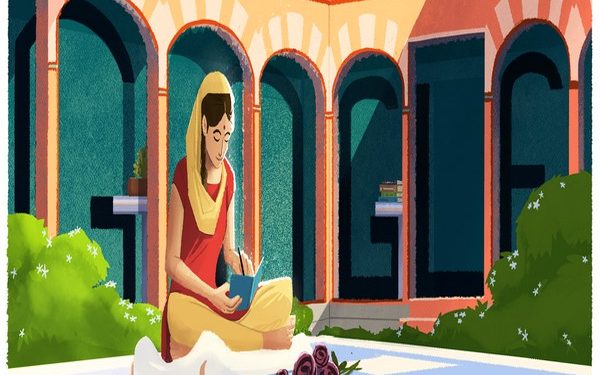New Delhi: Clad in a red and yellow salwar-kameez, her head demurely covered, she sits on a white sheet in a courtyard engrossed in a book, a sprig of roses at her feet. The archways behind her spell out Google as the global search engine honoured Punjabi-Hindi novelist, essayist and poet Amrita Pritam on her 100th birth anniversary.
As The Guardian noted in an obituary, Pritam’s death in New Delhi on October 31, 2005 aged 86, was “mourned on both sides of the India-Pakistan border, for it was she who chronicled so movingly and passionately the pain of partition in 1947”.
“Regarded as the leading 20th-century poet of the Punjabi language, she wrote verses that are sung and recited in cities and villages by many who are illiterate – such is the hypnotic appeal of her poetry. She was, in many ways, the voice of the Punjabi people, for her poems gave utterance to their anguish. She enshrined the concept of ‘Punjabiat’, the deep consciousness of being a Punjabi – a child of the land of the five rivers – irrespective of religious or caste affiliation.”
Born in Gujranwala in what is now Pakistan, Pritam was known as the most important voice for women in Punjabi literature. She became the first woman in 1956 to win the Sahitya Akademi Award for her magnum opus, a long poem titled “Sunehade” (Messages). She received the Bharatiya Jnanpith, one of India’s highest literary awards, in 1982 for “Kagaz Te Canvas” (The Paper and the Canvas).
But then, such was her stature that it was Pritam who honoured the awards rather than the other way around – the Padma Vibhushan, India’s second highest civilian award, in 2004 and before that the Padma Shri in 1969. Also in 2004 she was conferred with the Sahitya Akademi Fellowship for Lifetime Achievement as an “immortal of literature”.
She also received the Bulgarian Vaptsarov Award in 1979 and Degree of Officer dens, Ordre des Arts et des Lettres (Officier) from France. Nominated to the Rajya Sabha 1986-92, towards the end of her life, Pritam was honoured by Pakistan’s Punjabi Academy, to which she had remarked: “Bade dino baad mere maike ko meri yaad aayi” (My motherland remembered me after a long time).
Beginning her journey as a romantic poet, Pritam soon shifted gears and became part of the Progressive Writers’ Movement. Its effect was seen in “Lok Peed” (People’s Anguish) (1944), which openly criticised the war-torn economy after the Bengal famine of 1943.
Briefly working at the Lahore station of All India Radio before the partition of India, Pritam was also involved in social work participated in such activities wholeheartedly, after Independence when social activist Guru Radha Kishan took the initiative to bring the first Janta Library in Delhi, which was inaugurated by Balraj Sahni and Aruna Asaf Ali. This study centre-cum-library is still running at the Clock Tower in Delhi’s old quarters.
She married Pritam Singh, son of a leading hosiery merchant of Lahore’s Anarkali bazaar, in 1935, but left him in 1960. She is also said to have had unrequited affection for poet Sahir Ludhianvi, the story being depicted in her autobiography, “Rasidi Ticket” (Revenue Stamp). When another woman, singer Sudha Malhotra came into Sahir’s life, Pritam found solace in renowned artist and writer Imroz and spent the last 40 years of her life with him. Imroz designed most of her book covers and made her the subject of his several paintings. Their life together comes alive in “Amrita Imroz: A Love Story”.
In a career spanning over six decades, Pritam penned 28 novels, 18 anthologies of prose, five short stories and 16 miscellaneous prose volumes.
Such is what immortality is made of.






































